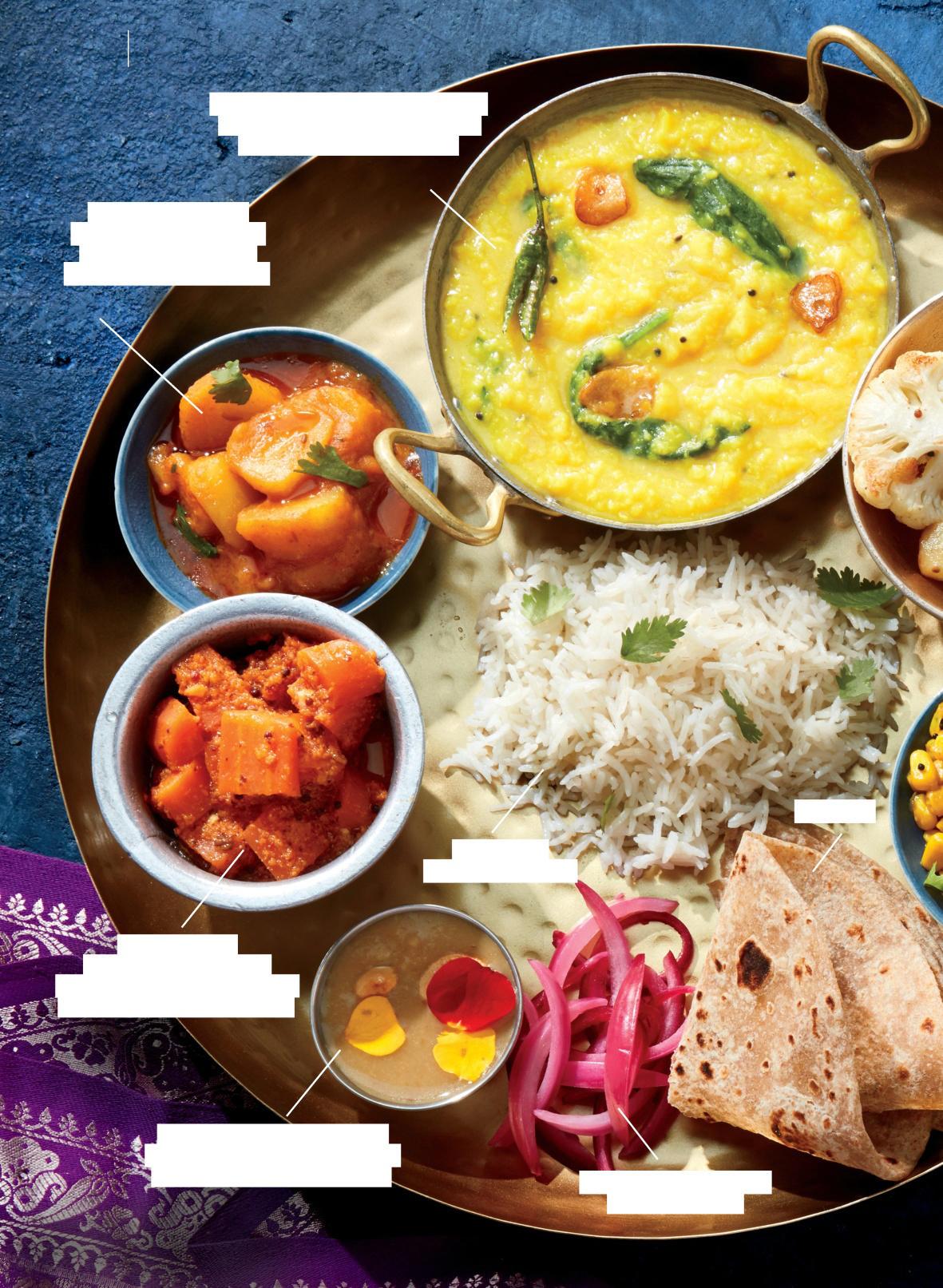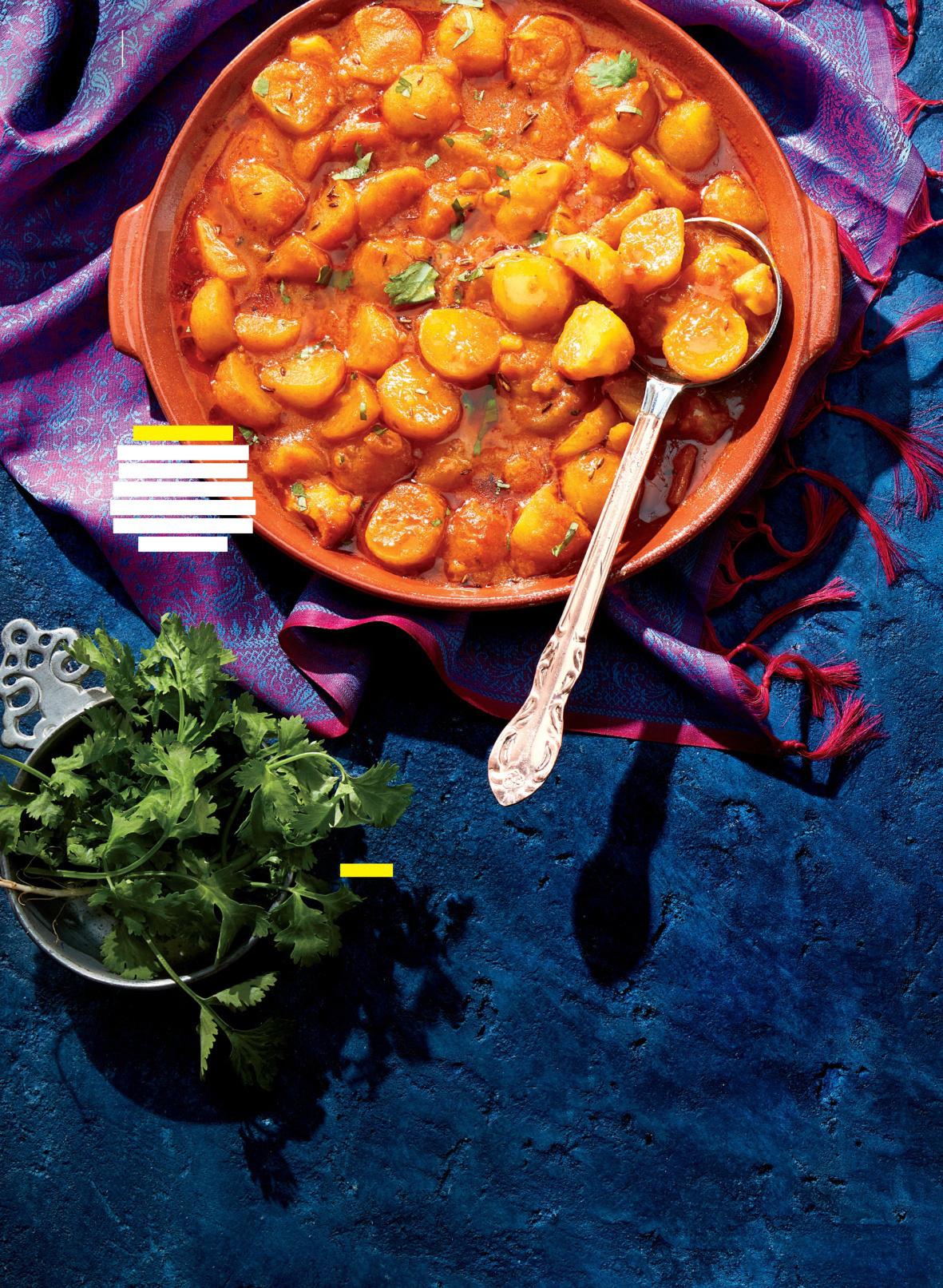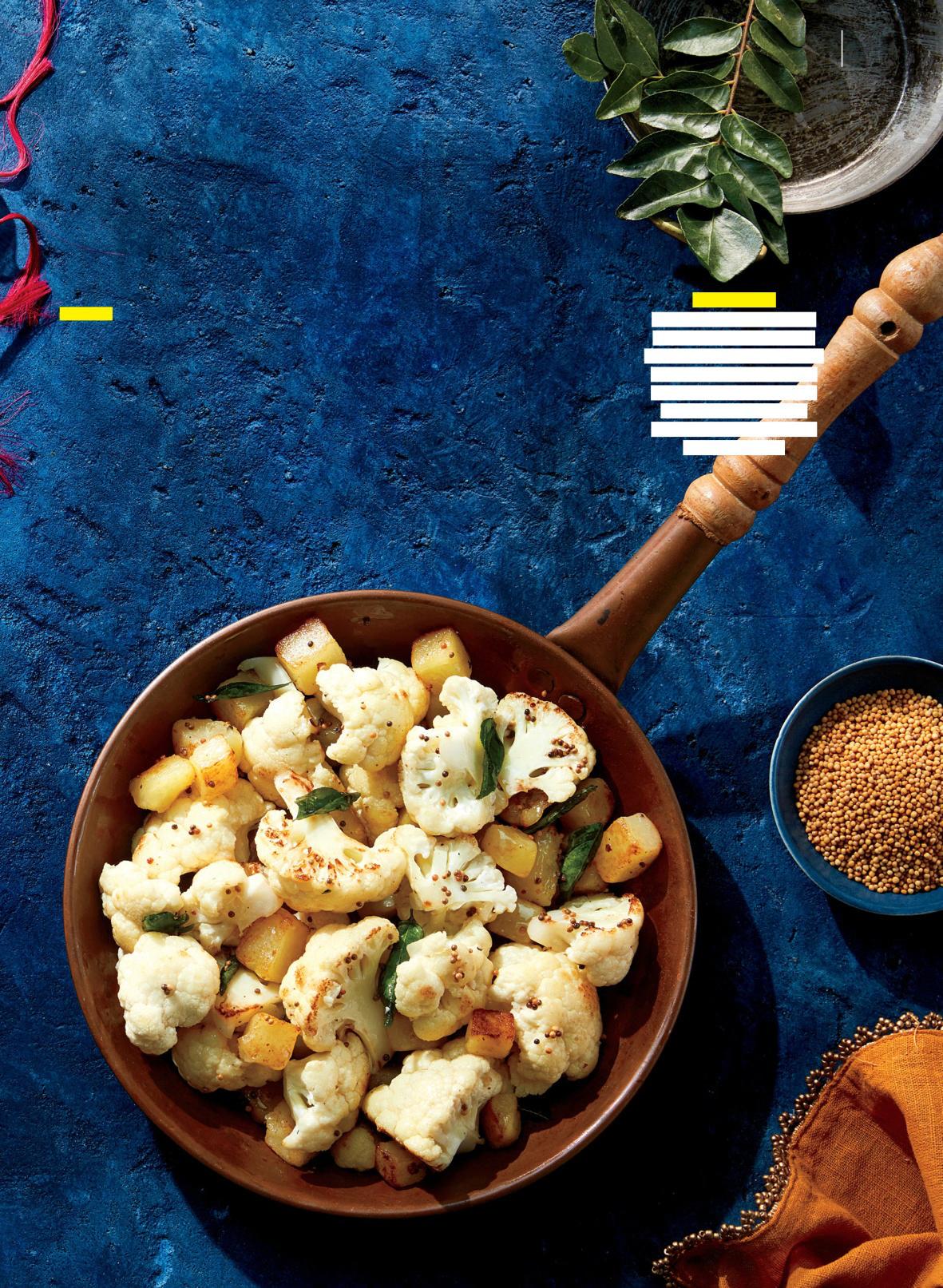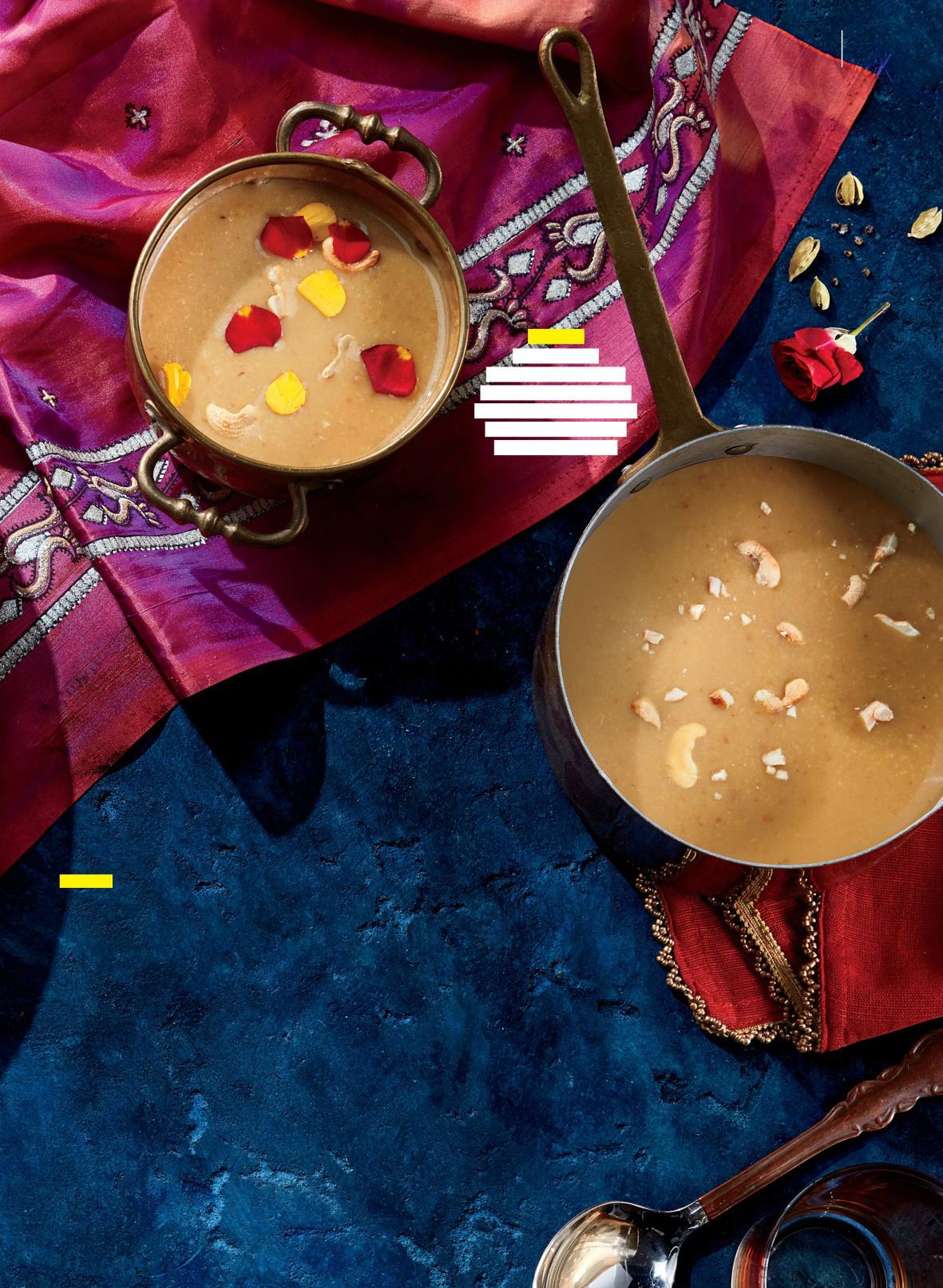
13 minute read
Feast on
2 . R A J A S T H A N I PA L A K D A L G A R L I C - S P I C E D S P I N A C H A N D L E N T I L D A L , P 8 4 A soup-like dal course.
1 . B E D M I A L O O S P I C E D T U R M E R I C A N D C O R I A N D E R P O TAT O C U R R Y, P 82 A vegetable curry course.
Advertisement
9 . A N D H R A C A R R O T PA C H A D I M A N G O , M U S TA R D A N D C A R R O T C H U T N E Y, P 86 A savoury condiment.
7 . P L A I N B A S M AT I R I C E 5 . R O T I
8 . PA R U P P U PAYA S A M S W E E T M O O N G D A L A N D C A S H E W P U D D I N G , P 87 A dessert course.
6 . Q U I C K- P I C K L E D R E D O N I O N S
3 . M A L A B A R M E Z H U K U P U R AT T I M A L A B A R - S P I C E D C A U L I F L O W E R , P 83 A savoury vegetable course.

4 . G U J A R AT I VA G H A R A M A K K A I S P I C Y C O R N , P 85 A dry, stir-fried vegetable course.
MAUNIKA GOWARDHAN SHARES HER LOVE OF THE CELEBRATION-ON-A-PLATTER THAT IS THALI
GROWING UP in Mumbai, Maunika Gowardhan always experienced movement around the dinner table, from quick weeknight meals to Sunday lunch. Her mother, who first inspired her to collect and record recipes, would put down a hearty dish with accompaniments doled out one by one throughout the meal: a soupy dal, then a pickle, then basmati rice topped with warm ghee. She loved when a glass of chilled chaas, a blitzed drink of buttermilk, ginger, cumin and cilantro, chased the food. “Even the most casual of dinners were like living thalis, though you wouldn’t immediately think of them that way, ” she says.
Now a London, U.K. -based chef and cookbook author, Gowardhan is referring to the formal thali, a Hindi word that denotes both a large round platter on which food is served and a dining format in which a complete multicourse meal is served on a single plate. It’s also the name of her latest cookbook, released in Canada on March 22, which is a compendium of recipes from across India that represent different regions and home-cooking styles.
Think of thali as a feast on a platter; smaller portions of multiple dishes served in little bowls. As Gowardhan points out, a thali’s composition has historic roots in Ayurvedic nutrition and taste principles, incorporating ingredients that feature sweet, sour, salty, pungent, bitter and astringent flavours. Often celebratory in nature and breathtaking in variety, thalis highlight the flavours and cooking techniques of a region, or the best of what a restaurant has to offer.
I grew up in a half-Goan family, and restaurants were exclusively how I experienced thalis. They were a treat I looked forward to as much as diner-style breakfast platters or the Pizza Hut sundae bar—the highest praise a child of ’90s suburban Toronto can heap on a meal. For years, that’s where they remained in my mind: too extravagant to cook myself.
Bridging this distinction between restaurant fare and home cooking is what makes Thali such a useful resource and a joy to read. Gowardhan’s recipes, amassed through years of research and travel, can easily be scaled up or down. “The stir-fried chapter is a perfect gateway for something quick and delicious, ” she says,
“served alongside a vegetarian curry or even just a recipe from the dal chapter. ” There are also prompts for incorporating leftovers and pantry items. From the book’s deep dive into the history of thali to its fresh preparations of vegetables—the malabar-spiced cauliflower is deceptively simple for how complex its flavours are—it’s not difficult to see why nearly a quarter of a million people follow Gowardhan on Instagram for cooking inspiration.
The thali Gowardhan has shared with us isn’t regionally specific, but rather recipes from across India that are mostly plant-based by nature— dishes that feature pulses and vegetables as star ingredients. “A lot of Indian food is inherently vegan, ” she says,
“and with a large percentage of the population having historically followed a vegetarian diet, it’s amazing to see how far we have come and amazing to see it have such a wide appeal. ” — Chantal Braganza
Mango powder Also known as amchur, this tangy seasoning is made from ground dried unripe mango and adds a bright, citrusy flavour to savoury dishes.
Bedmi Aloo (Spiced Turmeric and Coriander Potato Curry)

A delicious way to cook a classic potato curry with cumin, chili, turmeric and coriander in a light, soupy gravy. This simple-to-cook dish is savoured with puris (deep-fried bread).
Serves 4 Prep 15 min; total 50 min
5 cm ginger root, roughly chopped 2 green bird’s-eye chilies, roughly chopped 2 tbsp ghee or vegetable oil 1 tsp cumin seeds Pinch asafoetida 1⁄2 tsp Kashmiri chili powder 1 tsp ground turmeric 1 tsp ground coriander 1 tbsp tomato paste 700 g new potatoes, peeled and halved 2 1⁄2 cups water Pinch sugar Salt, to taste 1 tsp dried mango powder Chopped cilantro, to garnish 1. Put the ginger and chilies in a blender and blitz to a coarse paste, then set aside. 2. Heat the ghee in a heavy-based nonstick pan over medium heat. Working quickly, add the cumin seeds and asafoetida to the pan and fry for a few seconds until they sizzle, then add the ginger and chili paste and fry for a minute. 3. Add the chili powder, turmeric and coriander, then add the tomato paste and cook for 1 min, stirring well. Add the potatoes and mix gently for 1 to 2 min, making sure they are coated in the spices. Add the water and sugar, and season with salt to taste. 4. Bring to a boil, then cover and simmer over low heat for 30 min until the potatoes are cooked through. Crush some of them lightly to thicken the gravy. 5. Add the mango powder and cilantro. Turn off the heat. Serve with puris and raita or plant-based yogurt and pickle.
Malabar Mezhukupuratti (Malabar-Spiced Cauliflower with Ginger and Curry Leaves)
As much as this is an everyday recipe, don’t let the ease of it fool you in terms of taste. The flavours are a delight, with a robust infusion of gingery curry leaves that soaks into the cauliflower and potatoes.
Serves 4 Prep 10 min; total 35 min
3 tbsp vegetable oil 2 tsp mustard seeds 12 to 15 curry leaves, divided 5 cm ginger root, finely chopped 650 g cauliflower florets 2⁄3 cup water Salt, to taste 280 g potatoes, cubed and boiled 1⁄2 tsp coarsely ground black pepper 2 tbsp finely chopped cilantro 1. Heat the oil in a heavy-based saucepan over medium heat, then add the mustard seeds and let them sputter for 5 seconds. Add half of the curry leaves, along with the ginger, and fry for 20 seconds. Add the cauliflower and fry for another 4 min. Add the water and season with salt to taste. 2. Cover, reduce the heat and cook for 12 min, stirring halfway through to make sure cauliflower doesn’t stick to the bottom of pan. Add the pre-boiled potatoes and pepper and simmer for a further 4 to 5 min, without the lid, until the cauliflower is cooked, stirring well so it doesn’t stick. Most of the water should have reduced at this stage. 3. Turn off the heat and add the remaining curry leaves, along with the cilantro. Serve warm, with chapati flatbreads and some dal.
Curry leaves
Not to be confused with curry powder, which is a spice mix, this herb is sold dried and fresh, and is also called sweet neem. It’s used in many South Asian cuisines for its aroma and flavour: a mix of lemon balm, anise and allium.

Rajasthani Palak Dal (GarlicSpiced Spinach and Lentil Dal)
This creamy dal from the northwest of India is lightly spiced with cumin, turmeric and garlic, with the addition of fresh spinach.
Serves 4 Prep 5 min; total 45 min
1 1⁄3 cups moong dal (husked and halved yellow mung beans) 7 3⁄4 cups water, divided 1 tsp ground turmeric 3 tbsp ghee or sunflower oil 2 tsp black mustard seeds 1⁄2 tsp cumin seeds 5 garlic cloves, roughly chopped
1 green bird’s-eye chili, slit lengthwise Salt, to taste 100 g spinach, washed and chopped Juice of 1 lemon
1. Put the moong dal, 3 ¾ cups water and turmeric in a heavy-based saucepan over medium heat. Bring to a boil, then reduce the heat to low, half-cover and simmer for 30 min until the dal starts to get mushy, stirring a few times while it’s cooking. Turn off the heat, mash lightly with a potato masher and set aside. 2. Heat the ghee in a heavy-based saucepan over medium heat. Add the mustard and cumin seeds and fry for a few seconds until they begin to sputter. Add the garlic and chili and fry for a few seconds, moving them around in the pan to make sure they don’t burn. Reduce the heat to low, then add the cooked moong dal, a little at a time, and fry for a couple of minutes. 3. Season with salt to taste and add remaining 4 cups water. Cover and simmer over low heat for 4 min. Add the spinach and continue to simmer for a further 4 min, with the lid on. Add the lemon juice and stir. 4. Turn off the heat, remove chili (optional) and serve warm. This can be eaten with chapati flatbreads or rice.

Asafoetida Also known as hing, this pungent spice is made from the ferula plant. A pinch fried in oil will add onion-like savouriness and amplify the other spices in your dish.

Gujarati Vaghara Makkai (Spicy Corn with Ginger and Green Chili)
This stir-fried corn with ginger, green chili and turmeric is simple, quick and delicious, and a must to accompany every thali.
Serves 4 Prep 10 min; total 15 min
Chili and Ginger Paste 1 green bird’s-eye chili 3 garlic cloves, roughly chopped 5 cm ginger root, roughly chopped 4 cups canned corn kernels, drained, divided
3 tbsp vegetable oil Pinch asafoetida 1 heaped tsp black mustard seeds 1 tsp ground turmeric Salt, to taste 1 tbsp finely chopped cilantro 1 tbsp roasted peanuts, crushed Juice of 1⁄2 lime
1. Paste: Place chili, garlic and ginger in a blender, along with 3 tbsp of the corn. Blitz to a coarse paste. Set aside. 2. Heat the oil in a large frying pan over medium heat. Add the asafoetida and mustard seeds, and fry for a few seconds until they sputter. 3. Add the paste and fry for 1 min, stirring well. Add the turmeric and stir, then add the remaining corn and fry for 2 min. Reduce the heat to low, season with salt to taste, and add the cilantro and crushed peanuts. Cover and cook for 1 more minute. Finish with the lime juice and serve warm.
Andhra Carrot Pachadi (Mango, Mustard and Carrot Chutney)
This pachadi, or fresh pickle, hails from southern India and uses tadka— dried spices fried in oil to amplify their flavours—for its layered, complex taste.
Makes about 540 g Prep 30 min; total 40 min
4 dried red Kashmiri chilies 1 tbsp black mustard seeds 1⁄2 cup warm water 450 g carrots, peeled 120 g unripe mango
Tadka 3 tbsp vegetable oil Pinch asafoetida 1⁄2 tsp black mustard seeds 1 tsp fenugreek seeds 1 tbsp sugar Salt, to taste
1. In a bowl, soak the dried chilies and 1 tbsp mustard seeds in the warm water for 30 min. Dice half of the carrots finely and set aside. Cut the remaining carrots into rough chunks. 2. Put the chilies, mustard seeds and the soaking liquid into a blender and blend to a paste. Add the mango and rough carrot chunks and blend to a coarse paste. Set aside. 3. Tadka: Heat the oil in a heavy-based saucepan over medium heat. Add the asafoetida, 1⁄2 tsp mustard seeds and fenugreek seeds and fry for 2 or 3 seconds. Reduce the heat to low and add the finely diced carrots. 4. Cover and cook for 10 min over low heat, stirring halfway through, until the carrots soften slightly. Turn off the heat, and add the blended paste and sugar. Season with salt to taste and stir well. Serve with rice or dosas. You can store any leftover chutney in an airtight jar in the fridge for up to 1 week.

Kashmiri chili powder This scarlet-hued spice, also known as mirch, adds a vibrant red colour and subtle heat to foods.
Jaggery This unrefined sweetener is often sold in chunks or blocks. It’s made from sugar cane juice and/or date palm sap, and has a molasses-like flavour.
Paruppu Payasam (Sweet Moong Dal and Cashew Pudding with Cardamom and Jaggery)
Using lentils in desserts has always been common across India. This payasam can also be cooked with butter instead of coconut oil for a non-vegan version.
Serves 4 Prep 5 min; total 1 hr 5 min
2 tbsp coconut oil 1 tbsp vegetable oil 6 cloves 200 g moong dal (husked and halved yellow mung beans) 4 3⁄4 cups warm water, divided 200 g jaggery or soft dark brown sugar 8 cardamom pods, seeds only, ground to a powder 6 cashews, roughly broken 2⁄3 cup coconut milk
1. Heat the coconut and vegetable oils in a heavy-based saucepan over low heat. Add the cloves and fry for a few seconds, then add the moong dal and fry, stirring well, for 8 to 9 min. The colour will deepen as it fries. Slowly add 3 ½ cups water, making sure it doesn’t sputter. Increase the heat slightly, bring the mix to a boil, then cover and simmer over low heat for 50 min, stirring well a few times during cooking. 2. While the moong dal is cooking, in a separate saucepan, dissolve the jaggery in 1 ¼ cups water and simmer gently for 10 to 15 min. Set aside to cool slightly. 3. Take the lid off the moong dal and mash to thicken the mixture slightly. Cook for a further 5 min, stirring well to make sure it doesn’t stick to the bottom of the pan. 4. Add the jaggery water to the moong dal, along with the ground cardamom and cashews. Stir well and simmer without the lid for 10 min. Add the coconut milk and simmer for a further 2 to 3 min. Turn off the heat and serve in bowls, warm or cold. The payasam will thicken as it cools.











